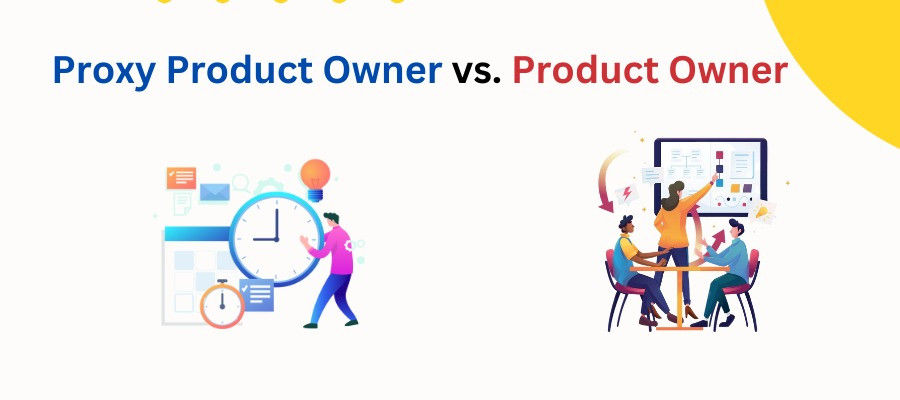Proxy Product Owner vs. Product Owner: Understanding the Key Differences

As organizations adopt Agile methodologies and embrace the principles of product development, the role of the Product Owner has become increasingly crucial. However, sometimes, organizations may opt for a Proxy Product Owner instead. While the two parts may seem interchangeable, significant differences between them can impact the success of a product development project.
This blog explores the critical differences between a Proxy Product Owner and a Product Owner. By the end of this article, you'll better understand which role is right for your organization and how to leverage the position to drive successful product development effectively.
Defining the Role of a Product Owner
The Product Owner (PO) plays a pivotal role as the representative of the customers within an Agile Squad. While the PO may collaborate with Subject Matter Experts (SMEs) to gather the Voice of the Customer (VoC), they possess sufficient knowledge to prioritize features and optimize the value delivered by the Agile Squad. Additionally, the PO validates these features, often with the assistance of SMEs.
One key aspect of the Product Owner's effectiveness lies in their proximity to the Agile Squad. By closely aligning with the team, the PO is a constant reminder of the business vision and strategy, mitigating the risk of straying off course.
The Product Owner also plays a crucial role in expediting time-to-market. They ensure a streamlined flow of business information and decisions, minimizing the risk of delays for the Agile Squad's progress.
Efficiency is another essential attribute of the Product Owner's responsibilities. By actively supporting the removal of any roadblocks on the business side, they help prevent the loss of valuable energy and resources for the Agile Squad. In cases where the Scrum Master's efforts may not suffice, the PO steps in to ensure operational efficiency.
How Functional Silos Lead to Proxy Product Owners In Organizations
Once upon a time, organizations structured themselves into functional silos—departments like sales, marketing, IT, and HR—each operating in its own bubble. This Taylorism-inspired setup fostered specialization but created barriers between "business" and "IT" roles. As Agile and Scrum gained traction, these organizations often misinterpreted the Product Owner role as a glorified bridge between business users and developers, leading to the rise of the Proxy Product Owner within IT departments.
Business leaders with the "MAN" (Money, Authority, Need) to make decisions often shy away from time-intensive backlog management. The result? Proxy Product Owners emerge, blending the skills of traditional project managers and business analysts to fill the gap. While efficient in the short term, this recipe dilutes the essence of a valid Product Owner—someone who embodies vision, prioritization, and end-to-end accountability for delivering value.
Understanding the Role of a Proxy Product Owner
A Proxy Product Owner (PPO) serves as an intermediary between the Product Owner (PO) and the Agile Squad, taking on certain activities on behalf of the PO. While this concept may not align with the principles of agility, certain benefits and drawbacks need to be carefully considered.
The Proxy PO, or PPO, operates within a specific scope explicitly delegated by the PO. They are fully empowered to make decisions within this scope without constantly consulting the PO.
However, it is essential to ensure that using a Proxy PO is not a means to address underlying anti-Agile practices. Anti-patterns related to the Product Owner role should be recognized and managed separately rather than relying on a Proxy PO as a workaround.
When implementing a Proxy PO, balancing benefits and drawbacks is crucial. While having an intermediary can provide certain advantages, such as enhanced efficiency or specialization, ensuring that the core principles of agility, including direct collaboration and shared ownership, are not compromised is essential.
Should Organizations Require A Proxy Product Owner?
A Proxy Product Owner can help when the primary Product Owner faces time constraints or is far from the Agile Squad. However, a Proxy PO should be a strategic decision, not a default workaround. The Product Owner must stay accountable, limit intermediaries, and collaborate closely with the Proxy PO to ensure alignment, clear communication, and minimal disruptions to Agile workflows.
Determining the Need for a Proxy Product Owner
Introducing a Proxy Product Owner (PPO) can be a solution in certain situations. These scenarios include:
- Limited Operational Availability of the Product Owner:
Suppose the designated Product Owner possesses the necessary knowledge and expertise but has constraints that limit their availability, such as time constraints or other responsibilities. In that case, a Proxy PO can be appointed to assist in managing the product.
- Geographical or Cultural Differences:
A Proxy PO can bridge the gap and facilitate effective communication and collaboration when the Product Owner and the Agile Squad are located in different regions with potential challenges such as varying time zones, languages, or cultural differences.
However, there are important considerations to keep in mind when assigning a Proxy PO:
- Single Proxy PO per Agile Squad:
To minimize complications and potential conflicts, having only one Proxy PO assigned to a specific Agile Squad is recommended. This ensures clarity and reduces the complexity introduced by having multiple intermediaries.
- Accountability of the Product Owner:
While a Proxy PO may assist in certain activities, it is crucial to remember that the Product Owner remains fully accountable for the product and the value delivered. The Proxy PO acts as a facilitator and representative but does not diminish the ultimate responsibility of the Product Owner.
- Close Collaboration between the Product Owner and Proxy PO:
To mitigate any negative impact of introducing a Proxy PO, the Product Owner, and the Proxy PO must maintain close communication and collaboration. This collaboration helps ensure alignment, minimize misunderstandings, and reduce any potential disruption caused by the intermediary role.
Who Can Act as a Proxy Product Owner in Agile Teams?
A Proxy Product Owner (PPO) typically understands Agile principles, the product vision, and business needs while closely aligning with the development team. In most cases, the following roles can take on this responsibility:
- Business Analysts (BAs): They bridge the gap between business and technical teams, making them well-suited to handle backlog refinement and requirement clarification.
- Project Managers (PMs): With experience managing scope, priorities, and stakeholder communication, PMs can act as a PPO when they embrace Agile values.
- Senior Developers or Tech Leads: When deep technical expertise is crucial, they can be a PPO to ensure business and technical alignment.
However, the PPO should never fully replace the Product Owner. Their role is to facilitate decision-making within a defined scope, ensuring that the PO remains accountable for the product’s direction and success.
Wrapping up
Understanding the critical differences between a Proxy Product Owner and a Product Owner is essential for organizations seeking to optimize their product development processes. The Product Owner plays a central role as the customers' voice, ensuring the product's alignment with their needs and priorities. They actively engage with the Agile Squad, facilitate decision-making, and streamline the flow of information.
Reference
- https://wind4change.com/product-owner-proxy-po-delegate-agile-scrum-what/




